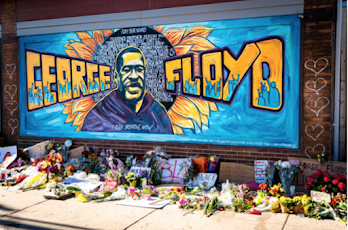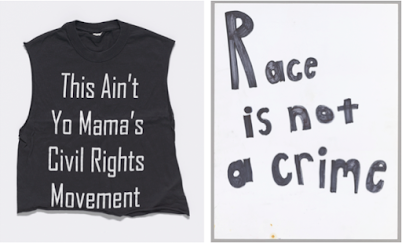As Nina Simone opined “[a]n artist’s duty, as far as I’m concerned, is to reflect the times.” That reflection can capture not only the joy and beauty of the world, but also the pain, anger, and injustice. Ms. Simone’s statement has held true throughout many periods of social upheaval, including this past year when artists came out in full force to document and participate in the racial justice movement that spread throughout the country and world. No single type of medium has been used to depict and explore the movement's messages, and works range from photography to poetry to dance to street art and beyond. With the near-instantaneous availability to share photos and videos social media, many of these works, such as the now-iconic mural at the George Floyd Memorial depicted below, have been captured and spread widely.
Some types of media are ephemeral and can be difficult to preserve and this is particularly true for murals and street art. Given the impermanent nature of these pieces, museums and others are working to insure that they are collected and maintained for future generations. One such project from the Urban Art Mapping project is the George Floyd & Anti-Racist street art database. This database documents and catalogs the work of street artists and members of the public are encouraged to submit photos of the art they see on the streets in their neighborhoods to add to the collection.
Even those who do not necessarily think of themselves as “artists” are able to contribute to story of this movement through tangible items used in protests and demonstrations. For example, pieces on display at the National Museum of African American History & Culture include a t-shirt worn by Rahiel Tesfamariam at a protest commemorating Michael Brown in 2015 and a protest sign from 2015, both shown below. You can explore the Museum's entire collection of objects related to activism from various times in history here.
These pieces, together with the more traditional works, help paint a broad picture of this movement and the many ways that people participate, express themselves, and make their voices heard.
Want to further explore the interplay of art, protest, and activism? Check out the following:
Read:
- Thessaly La Force, Zoe Lescaze, Nancy Hass & M.H. Miller, The 25 Most Influential Works of American Protest Art Since World War II, N.Y. Times Style Magazine (Oct. 15, 2020)
- Liz McQuiston, Protest! A History of Social and Political Protest Graphics (2019)
- Makeda Best & Miguel de Baca, Conflict, Identity, and Protest in American Art (2015)
Listen:
- Art, Activism, Race and the Law, Nasher Museum of Art (April 18, 2017)
- Who We Be: Superpanel on Art, Protest and Racial Justice, Bay Area Society for Art & Activism (April 4, 2015)
- Marcus Ellswoth, Art as Activism, TEDx (Nov. 15, 2014)



No comments:
Post a Comment